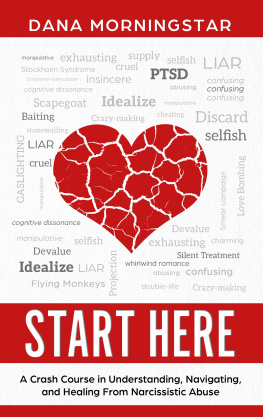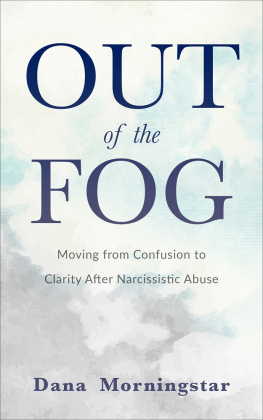The Narcissist's Playbook
Other Book s by the Author
Start Here: A Crash Course in Understanding, Navigating, and Healing from
Narcissistic Abuse
Out of the Fog: Moving f rom Confusion to C larity After Narcissistic Abuse
Insigh t Journal: A Three-Year Journal
The Five-Minute Gratitude Journal: A One-Year Journal
The Narcissists Playbook:
How to Win a Game You Never Intended to Play
Dana Morningstar
Dedication
To everyone who is struggling to put the pieces of their life back together after a manipulative relationship. You are not alone, and you can do this.
A special thank you to Marisol, Agata, and my mother for all your feedback, insight, time, and support.
Disclaimer
This book is not intended to diagnose or treat anyone. Additionally, all names and examples have been changed to protect the identify of those involved. Any likeness to persons either living or dead is purely coincidental.
COPYRIGHT
Copyright 2019 by Dana Morningstar
All rights reserved. This book or any portion thereof
may not be reproduced or used in any manner whatsoever
without the express written permission of the publisher
except for the use of brief quotations in a book review.
Printed in the United States of America
First Printing, 2019
Morningstar Media
PO Box 464
Mason, MI 48854
Table of Contents
Part 1: Understanding Manipulation
graph-definition>
Chapter 1: We All Think We Can Spot a Problem for What It Is
graph-definition>
Chapter 2: Why We Tend to Think Bad Things Won't Happen to Us
graph-definition>
Chapter 3: Seeing Manipulation as It's Happening
graph-definition>
Chapter 4: What Manipulation Is and Isn't
graph-definition>
Chapter 5: Who Can Be Manipulated and Who Can Be Manipulative
graph-definition>
Chapter 6: Subcategories of Manipulators
graph-definition>
Chapter 7: Understanding the Mindset of Manipulators
graph-definition>
Chapter 8: Common Methods of Manipulation
graph-definition>
Chapter 9: Understanding Crazy-Making Conversations
graph-definition>
Chapter 10: The Different Levels of Manipulative Behavior
Part 2: Understanding the Hooks that Have You
graph-definition>
Chapter 12: Signs You Are Being Manipulated
graph-definition>
Chapter 13: Understanding Trauma Bonds
graph-definition>
Chapter 14: The Progression of Manipulation
graph-definition>
Chapter 15: The Psychological Progression of the Target
graph-definition>
Chapter 16: Seven Points to Consider Before Starting Couple's Counseling
graph-definition>
Chapter 17: Can They Change?
Part 3 : Breaking Free f rom Manipulation
graph-definition>
Chapter 19: Getting a Game Plan
graph-definition>
Chapter 20: Understanding and Anticipating the Manipulator's Moves
graph-definition>
Chapter 21: Know Who is Really on Your Team
graph-definition>
Chapter 22: Understanding How You Handle Conflict and Stress
graph-definition>
Chapter 23: Understanding Your Vulnerabilities
graph-definition>
Chapter 24: Examining Your Self-Esteem and Frequently Exploited Personality Traits
graph-definition>
Chapter 25: Boundaries, Standards, and Deal Breakers
Part 4: Winning the Game
graph-definition>
Chapter 27: Changing How You Respond
graph-definition>
Chapter 28: Developing Your Strategies
graph-definition>
Chapter 29: Practicing Your Strategies
graph-definition>
Conclusion
Part 1: Understanding Manipulation
Introduction
One of the most frequently-asked questions I get is how can it be possible that narcissists and other types of manipulative people, who have never met, can behave in almost the exact same way--sometimes down to saying the same things. While some are worse than others, they are still shades of the same color, leaving many survivors to wonder if they have some sort of playbook that guides their behavior.
The first two parts of this book cover everything having to do with manipulation that would be in a playbook if one existed. However, because understanding manipulation is only half the battle, the last two parts of this book cover how to break free from manipulation once and for all.
As you go through this book, you will most likely start to identify problematic behavior that many of the people in your life have. You may also become aware of some of your own problematic behaviors that you have developed, either as a way of coping with a dysfunctional relationship or as a result of a dysfunctional upbringing. This can be concerning and can cause a person to wonder if they are manipulative, or if they are the problem.
Please don't panic and think you are a narcissist. Narcissism is a personality trait that we all have, and it exists on a continuum ranging from healthy to deadly. Healthy narcissism is when our level of self-orientation is such that we realize that we matter and are worth valuing and making a priority. We need to have a healthy level of narcissism if we are going to be able to set goals and be able to be self-protective. Narcissism only becomes problematic when a person's level of self-orientation is such that they are solely focused on themselves at the expense of, or to the destruction of, others.
If this book does its job, then it will bring to light a whole host of behaviors and personality traits that are problematic when taken to an extreme. The vast majority of people out there (myself included) have or had some of these traits. This is normal and is the result of growing up in a dysfunctional home or society, which we all do. If you are introspective, odds are you will see some of these traits within yourself. These traits don't make you bad, wrong, or somehow to blame. Being manipulated or abused is never your fault. Most of the time we've developed these traits as a way to cope, and I hope that by the end of this book you'll be able to see human behavior--others as well as your own with a level of clarity you need in order to move forward and heal.
Chapter 1: We All Think We Can Spot a Problem for What It Is
We all think we'd be able to see a problematic situation for what it is, and be able to get out of harm's way. And most of the time we would be wrong. I recently came across a video that was tragic because of the magnitude of the situation, and upsetting because of the comments that were made. The video was of two tourists filming their afternoon on a beach in Thailand. While they were recording, the ocean began to recede. Moments later, numerous boats that had been docked in several feet of water, were now left teetering on wet sand. With this realization, the tourists' laughter and good times were quickly replaced by confusion and chaos.
The camera panned around to capture this strange new shoreline. Dozens of confused tourists just like them stared into the sandy distance, trying to make sense of what was happening. Their stunned silence was soon replaced with attempts to make sense of what was happening. One tourist asked another if perhaps the receding water could have something to do with the earthquake that happened earlier that day. The other tourist didn't think it was related.
Their conversation was cut short by a loud commotion off in the distance. The camera then panned to dozens of panicked locals running as fast as they could away from the beach. Confused by what the locals knew that they didn't, the tourists turned the camera back towards the ocean. This time there was more to see than hundreds of feet of wet sand; there was a strange-looking wave off in the distance. Still uncertain about what was going on, but knowing that if the locals were running they probably should too, the tourists joined in the mad dash away from the shore.












